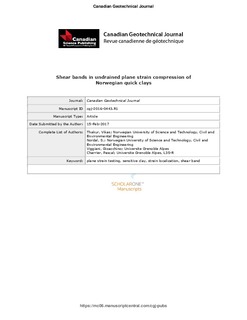| dc.contributor.author | Thakur, Vikas Kumar Singh | |
| dc.contributor.author | Nordal, Steinar | |
| dc.contributor.author | Gioacchino, Viggiani | |
| dc.contributor.author | Charrier, Pacal | |
| dc.date.accessioned | 2019-04-01T13:34:27Z | |
| dc.date.available | 2019-04-01T13:34:27Z | |
| dc.date.created | 2019-01-18T08:50:17Z | |
| dc.date.issued | 2018 | |
| dc.identifier.citation | Canadian geotechnical journal (Print). 2018, 55 (1), 45-56. | nb_NO |
| dc.identifier.issn | 0008-3674 | |
| dc.identifier.uri | http://hdl.handle.net/11250/2592746 | |
| dc.description.abstract | This work presents the results of plane strain tests carried out at the Laboratoire 3SR Grenoble (France) on undisturbed samples of very sensitive Norwegian soft clay. Discussion of the results focuses on the observed failure mechanisms and zones of localized deformation. The tested clay is defined as quick clay because it liquefies completely upon remolding. Thus, careful handling was necessary, and original procedures were developed to place samples in the plane strain testing device with minimum disturbance. Results show that excess pore-water pressure had developed during shear loading and shear strength was lost after the peak, which is a typical phenomenon in sensitive soils. The sample was held between two glass plates to enable visual tracking of the deformations. A digital image correlation analysis revealed a complex pattern of emerging shear bands, with one or two bands dominating and providing a final failure mechanism. Two local pore-water pressure transducers were attached to the sample boundary and showed differences in local excess pore-water pressure. It is suggested that excess pore-water pressure depends on the distance from the transducers to the zones of concentrated shear strains. | nb_NO |
| dc.language.iso | eng | nb_NO |
| dc.publisher | NRC Research Press | nb_NO |
| dc.title | Shear bands in undrained plane strain compression of Norwegian quick clays | nb_NO |
| dc.type | Journal article | nb_NO |
| dc.type | Peer reviewed | nb_NO |
| dc.description.version | acceptedVersion | nb_NO |
| dc.source.pagenumber | 45-56 | nb_NO |
| dc.source.volume | 55 | nb_NO |
| dc.source.journal | Canadian geotechnical journal (Print) | nb_NO |
| dc.source.issue | 1 | nb_NO |
| dc.identifier.doi | 10.1139/cgj-2016-0443 | |
| dc.identifier.cristin | 1659873 | |
| dc.description.localcode | © 2018. This is the authors' accepted and refereed manuscript to the article. The final authenticated version is available online at: https://doi.org/10.1139/cgj-2016-0443 | nb_NO |
| cristin.unitcode | 194,64,91,0 | |
| cristin.unitname | Institutt for bygg- og miljøteknikk | |
| cristin.ispublished | true | |
| cristin.fulltext | postprint | |
| cristin.qualitycode | 1 | |
